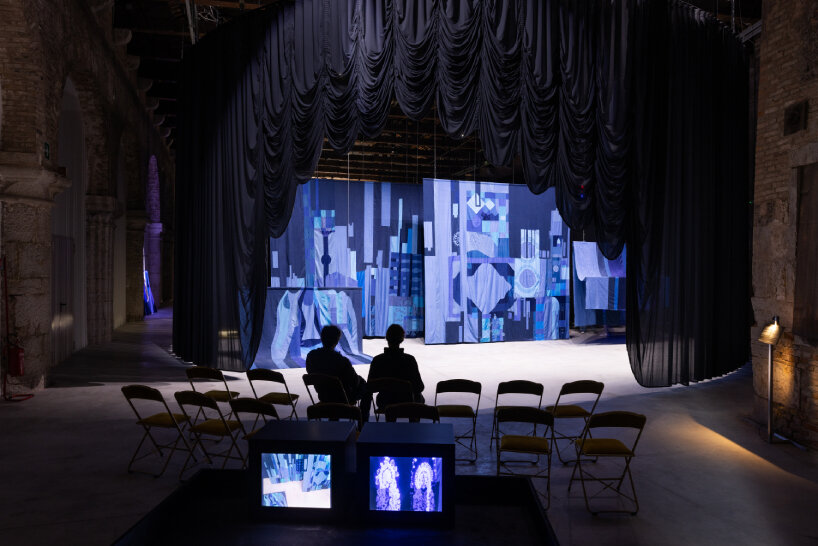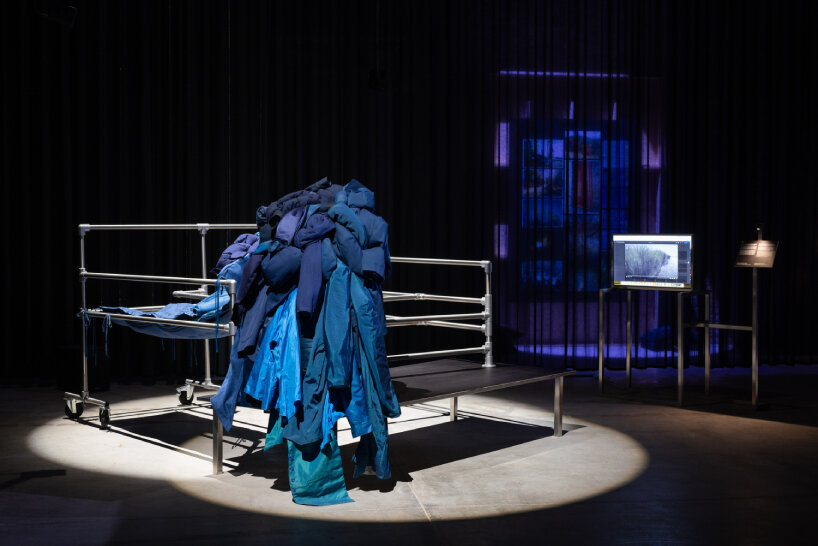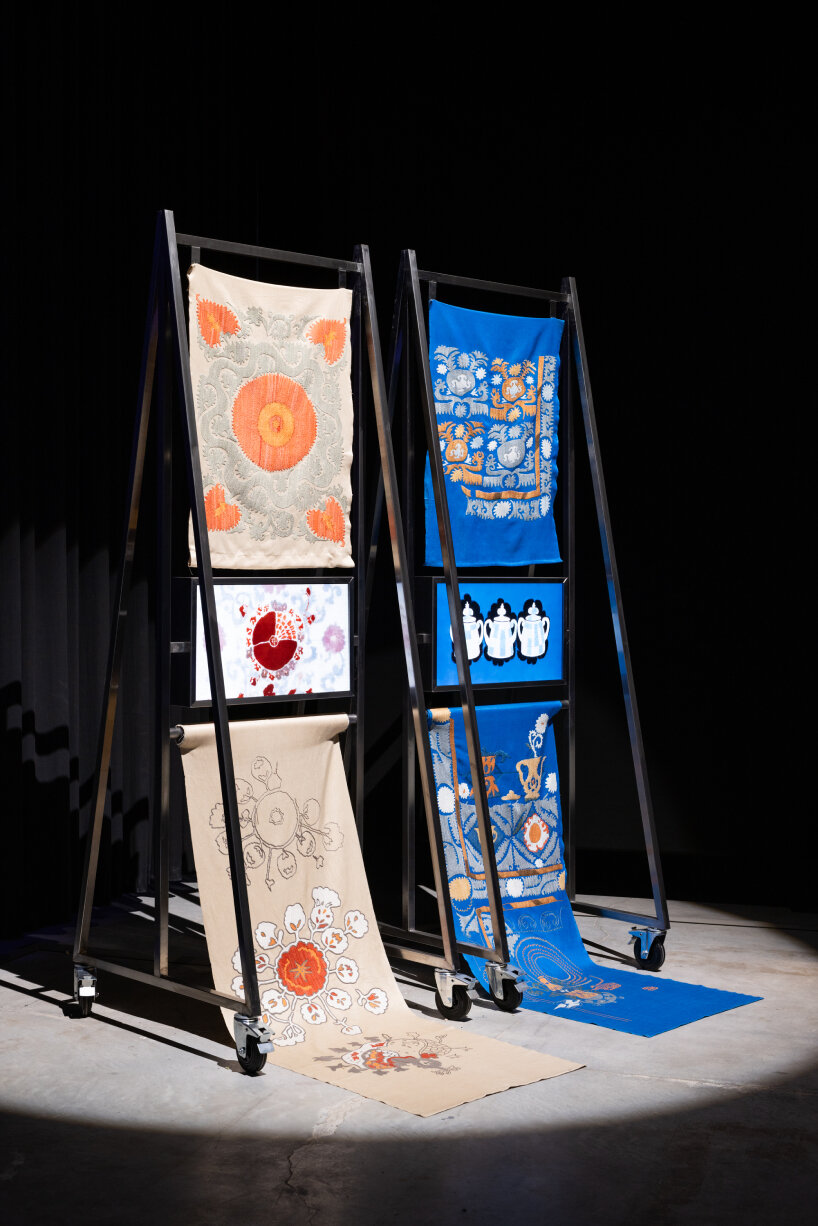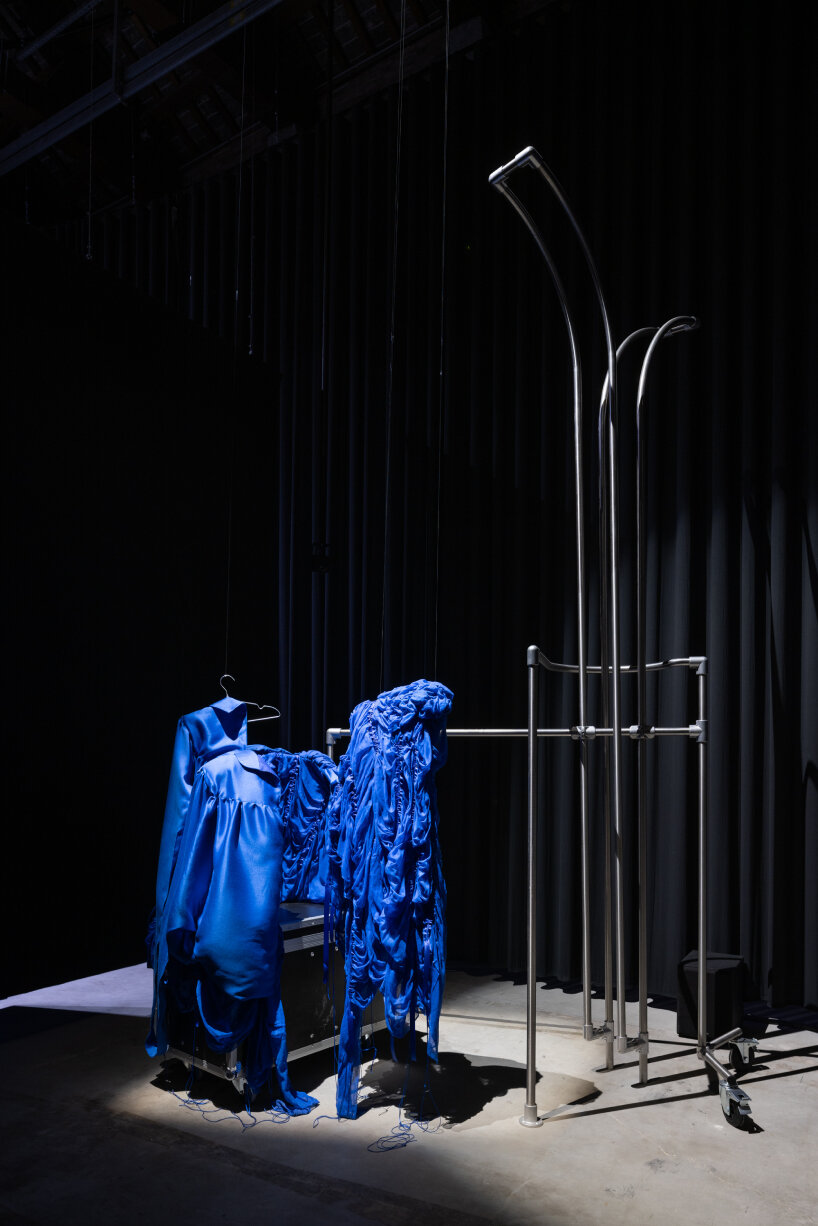inside the uzbekistan pavilion at the 60th venice art biennale
Wading through hues of blue, patchwork tapestries, and suzani embroidery, the Uzbekistan Pavilion at the 60th Venice Art Biennale is a theatrical staging of collective voices and cultural memory. Artist Aziza Kadyri turns the pavilion, titled Don’t Miss the Cue, into a deconstructed backstage of a theater — a dimly lit room with hidden corners, lined with heaps of costumes, reconfigured hanging rails, and digital screens. Visitors wind through a sensorial yet obscure journey that culminates as they emerge onto an open stage illuminated by spotlights and activated by the gaze of resting ‘audience’ members — a nod to Kadyri’s background in theater.
Speaking with designboom, the artist reflects on how this concept is one that is both deeply personal and representative of the collective experiences of Central Asian women. ‘When representing a country,’ she shares, ‘it’s crucial to bring in a multiplicity of voices, especially those that are often underrepresented, like the younger generation of women who grew up after Uzbekistan’s independence in 1991.’ Kadyri then worked closely with the Qizlar Collective (Qizlar meaning ‘girls’), a group of female artists giving a stage to the narratives of these women, translating their postcolonial memories in search for identity, and their resilience, into poetic design installations. The works as such urge reflection and interaction, even inviting visitors to step inside the textiles and embody their weight. ‘The whole idea is to transmit a bodily sensation — a sense of corporeality. The audiovisual elements also attempt to represent these experiences of the community in a more indirect and emotional way,’ Kadyri adds. Read on for our full conversation.

all images courtesy of ACDF
a journey through a deconstructed theater backstage
Though part of the Uzbek diaspora herself, Aziza Kadyri further looks to her heritage to question what it means to be a creative working with traditional practices today. In collaboration with master embroiderer Madina Kasimbaeva who has been working with embroidery for 25 years, she reimagines artisanal forms with technology. AI, an increasingly prevalent tool within our contemporary creative fabric, is trained to reinterpret an archival body of suzani patterns which Kasimbaeva with her team materialized across the pavilion’s hanging curtains and embroideries — their forms oscillating between past, present, and future.
Notably, for both the artist and the artisan, technology is not at odds with tradition. While Kadyri likens traditional Uzbek suzani works to historical documents and their associated processes as a record of female collectivity, AI becomes a modern tool to remember and reinterpret them for contemporary contexts. The integration of AI, which the artist refers to as a globalized ‘vessel for collective memory,’ modernizes the visual language of the patterns to strengthen their resonance with newer generations. ‘During our discussions, Madina mentioned that some patterns didn’t reflect her experience as a woman in the 21st century. Then conversations ensued that sparked a search for innovation — how it’s okay to break from tradition and create something that represents your current reality,’ the artist tells designboom. Read the full interview below.

aziza kadyri on collective memories at don’t miss the cue
designboom (DB): Your representation of your nation brings together a range of voices in the community, heritage, and traditions. Can you begin with introducing these collaborations?
Aziza Kadyri (AK): Initially, I was asked to do a solo, but a lot of my practice is collective. When representing a country, it’s crucial to bring in a multiplicity of voices, especially those that are often underrepresented — like the younger generation of women who grew up after Uzbekistan’s independence in 1991. So, I invited the Qizlar Collective, which I co-founded, to join me in this project. We focused on the experiences of young women within our community, especially how life has changed post-independence.
We also worked with a fantastic artisan embroiderer, Madina Kasimbaeva. This ties into another strand of my practice, where I explore the visual language of embroidery as a historical document, a way women recorded their hopes and dreams over the centuries. We wanted to modernize that tradition, to reimagine it using contemporary technology.

DB: What inspired this spatial concept of an abstract experiential journey ending upon a stage?
AK: I came up with this idea of a deconstructed backstage of a theater, which draws from my experience of traveling through different countries by working in theaters. I’ve worked as a theater designer, scenographer, and costume designer for a long time, and I think those traces of storytelling persist in everything I do.
Backstage, to me, became a metaphor for this collection of disparate objects. When you go backstage, you find costumes from one play and props for another, all bunched together. They somehow tell a story, even if it doesn’t make immediate sense. That process of picking up pieces — of identity, of memories — feels similar to what I and many of the women we spoke to have experienced. In this way, my work is also very performance-focused, but it’s never direct. I feel that putting things poetically actually communicates more, and that’s something we tried to capture with the pavilion.

DB: Do these ideas of migration and performance extend to the visitor experience too?
AK: I design experiences, and my theater background, along with my work in immersive experiences and technology, drives me to create specific emotional responses at certain moments. There’s a twist to the journey of walking through the works in the dark because you go through, then you’re suddenly on stage, with people staring at you. Here, I wanted people to feel a sense of discomfort, something they could either accept or reject. They could either step off the stage or become one of the ‘performers’.

